cruise control PONTIAC BONNEVILLE 1996 Owners Manual
[x] Cancel search | Manufacturer: PONTIAC, Model Year: 1996, Model line: BONNEVILLE, Model: PONTIAC BONNEVILLE 1996Pages: 387, PDF Size: 18.71 MB
Page 85 of 387
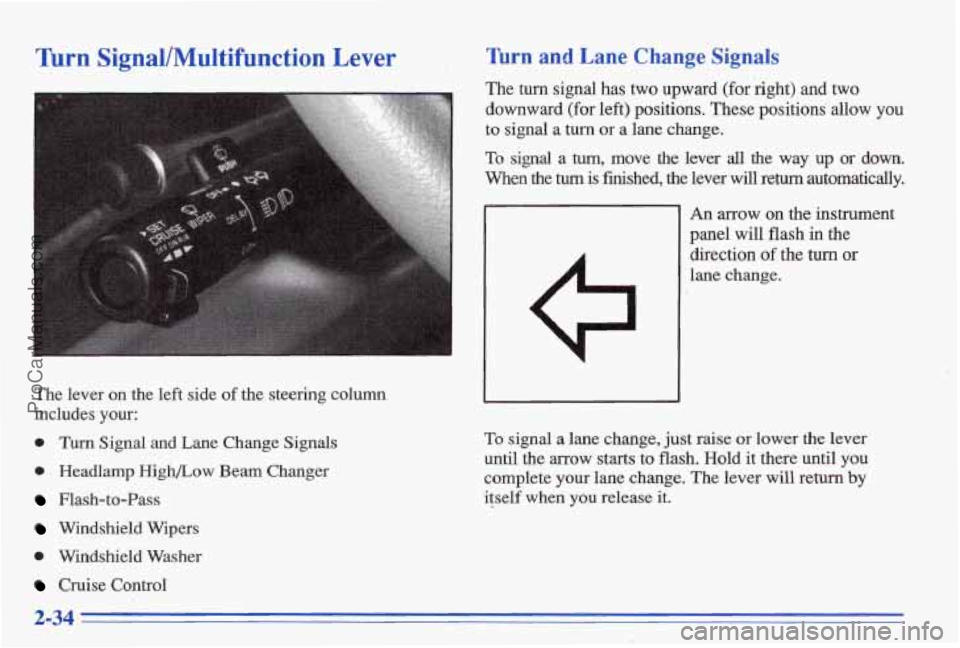
Turn Signal/Multifunction Lever
The lever on the left side of the steering column
includes
your:
0 Turn Signal and Lane Change Signals
0 Headlamp HighLow Beam Changer
Flash-to-Pass
Windshield Wipers
0 Windshield Washer
Cruise Control
Turn and Lane Change Signals
The turn signal has two upward (for right) and two
downward (for left) positions. These positions allow
you
to signal a turn or a lane change.
To signal
a tum, move the lever all the way up or down.
When the turn is finished, the lever will return automatically.
An mow on the instrument
panel will flash
in the
direction
of the turn or
lane change.
To signal a lane change, just raise or lower the lever
until the arrow starts to flash. Hold it there until you
complete your lane change. The lever will
return by
itself when you release it.
2-34
ProCarManuals.com
Page 88 of 387

Windshield Washer
At the top of the turn signal/multifunction lever there’s a
paddle with the word
PUSH on it. To spray washer fluid
on the windshield, push the paddle for less than a
second. The wipers
will clear the window and either
stop or return to your preset speed. For more washer
cycles, push and hold the paddle. Remember, driving
without washer fluid can be dangerous.
A bad mud
splash can block your vision. You could hit another
vehicle or go
off the road. Check your washer fluid
level often.
Some models have a WASHER
FLUID warning, that
indicates
if the fluid level in the windshield washer
reservoir is low. See “Low Washer Fluid Warning Light”
in
the Index.
A CAUTION:
In freezing weather, don’t use your washer until
the windshield is warmed. Otherwise the washer fluid can form ice on the windshield, blocking
your vision.
Cruise Control
on the accelerator. his can
really help
on long trips.
Cruise control does not work at speeds below about
25 mph (40 km/h).
When you apply your brakes, the cruise control
shuts
off.
ProCarManuals.com
Page 89 of 387

A CAUTION:
~~~ ~ ~ ~ ~~~ ~
Cruise control can be dangerous where you
can’t drive safely at
a steady speed. So,
don’t use your cruise control on winding
roads or in heavy traffic,
slippery roads. On such roads, fast changes
in tire traction can cause needless wheel
spinning, and you could lose control. Don’t
use cruise control
on slippery roads.
Cruise control can be dangerous on
If your vehicle is in cruise control when the optional
traction control system begins to limit wheel spin, the
cruise control
will automatically disengage. (See
“Traction Control
System” in the Index.) When road
conditions allow you to safely use it again, you may turn
the cruise control back
on.
Ifyou leave your cruise control switch on when
you’re not using cruise, you might hit
a button and
go into cruise when youldon’t want to. You could
be startled and even
lose control. Keep the cruise
control switch
OFF until you want to use it.
1. Move the cruise control switch to ON.
2. Get up to the speed you want.
3.
4.
Push in the SET button
at the end of the lever
and release it.
Take your foot
off the
accelerator pedal.
’ 2-38
ProCarManuals.com
Page 90 of 387
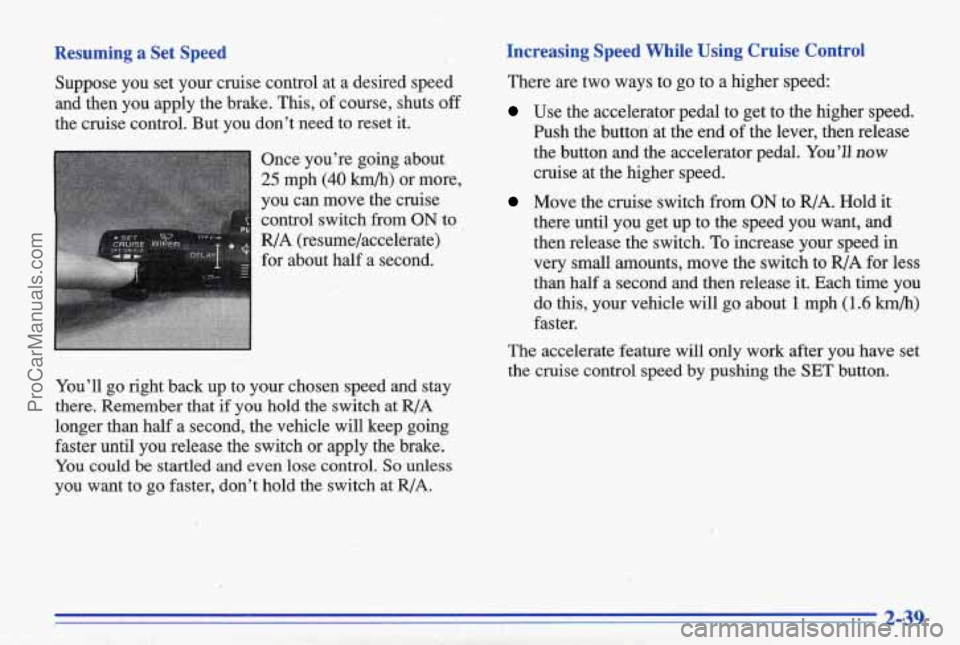
Resuming a Set Speed
Suppose you set your cruise control at a desired speed and then you apply the brake.
This, of course, shuts off
the cruise control. But you don’t need to reset it.
Once you’re going about
25 mph (40 km/h) or more,
you can move the cruise control switch
from ON to
R/A (resume/accelerate)
for about half a second.
You’ll go right back up to your chosen speed and stay
there. Remember that if you hold the switch at
R/A
longer than half a second, th’e vehicle will keep going
faster until you release the switch or apply the brake.
You could
be startled and even lose control. So unless
you want to go faster, don’t hold the switch at
R/A.
Increasing Speed While Using Cruise Control
There are two ways to go to a higher speed:
Use the accelerator pedal to get to the higher speed.
hsh the button at the end
of the lever, then release
the button and the accelerator pedal.
You’ll now
cruise at the higher speed.
Move the cruise switch from ON to R/A. Hold it
there until you get up to the speed you want, and
then release the switch.
To increase your speed in
very small mounts, move the switch to R/A for less
than half a second and then release it. Each time you
do this, your vehicle will go about 1 mph (1.6 km/h)
The accelerate feature will only work after you have set
the cruise control speed by pushing the
SET button.
, faster.
1.
2-39
ProCarManuals.com
Page 91 of 387
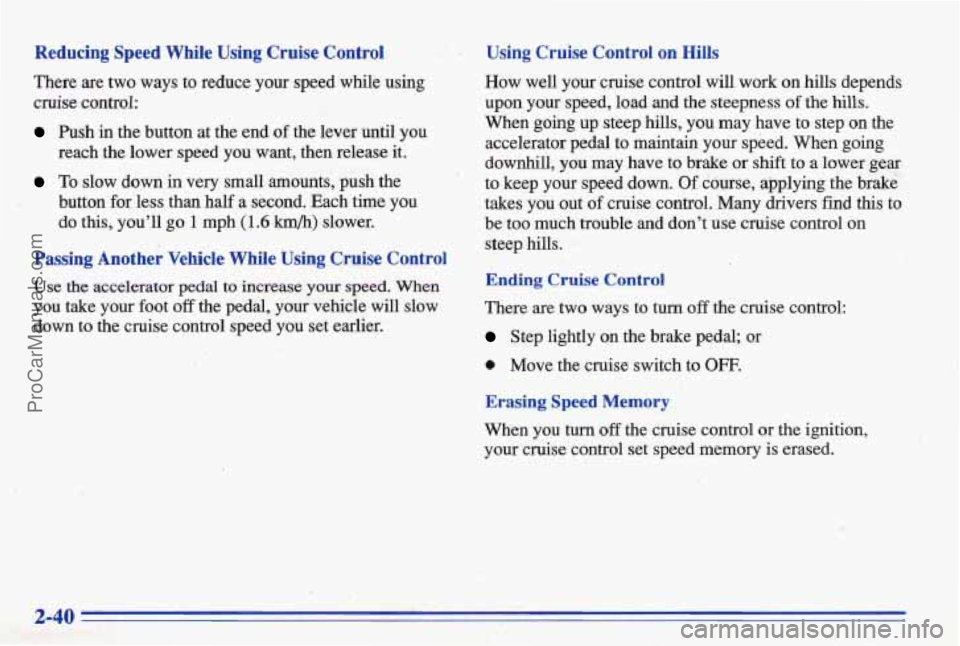
Reducing Speed While Using Cruise Control
There are two ways to reduce your speed while using
dse control:
Push in the button at the end.of the lever until you
reach the lower speed you want, then release it.
To slow down in very small amounts, push the
button for less than half
a second. Each time you
do this, you'll go 1 mph (1.6 h/h) slower.
Passing Another Vehicle While Using Cruise Control
Use the accelerator pedal to increase your speed. When
you take your foot
off the pedal, your vehicle.will slow
down to the cruise control speed you set earlier.
Using Cruise Control on Hills
How well your cruise control will work on hills depends
upon your speed, load and
the steepness of the hills.
When going up steep
hills, you may have to step on the
accelerator pedal to maintain your speed. When going
downhill, you may have
to brake or shift to a lower gear
to keep your speed down.
Of course, applying the brake
takes you out of cruise control. Many drivers
fiid this to
be too much trouble and don't use cruise control on
steep hills.
Ending Cruise Control
There are two ways to turn off the. cruise control:
Step lightly on the brake pedal; or
0 Move the 'cruise switch to OFF.
Erasing Speed Memory
When you turn off the cruise control or the ignition,
your cruise control set speed memory is erased.
2-40
ProCarManuals.com
Page 175 of 387
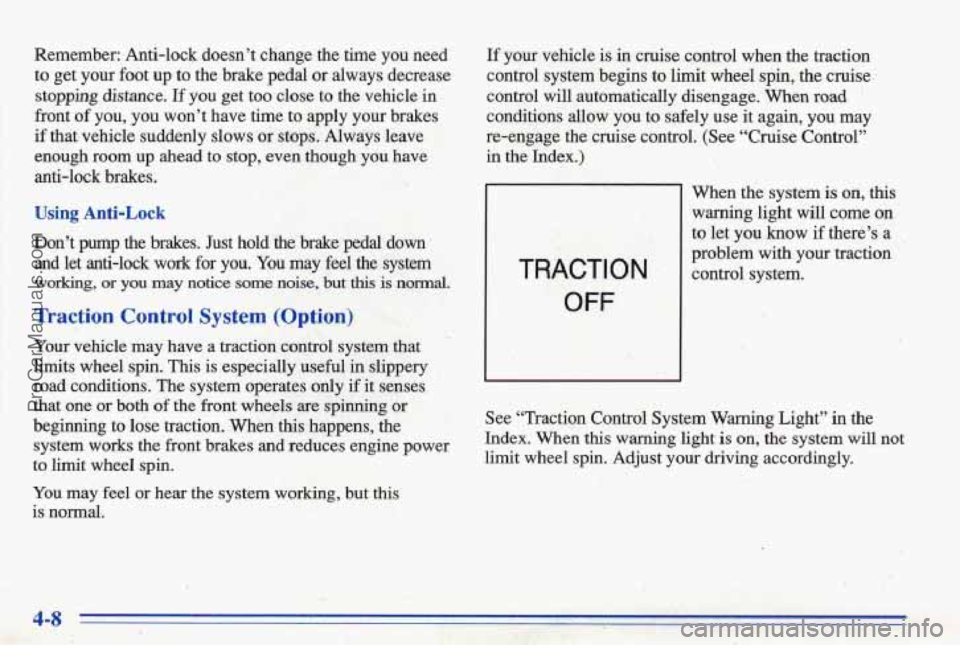
Remember: Anti-lock doesn’t cfiange the time you need
to get
your foot up to the brake pedal or always decrease
stopping distance. If you get too close to the vehicle in
front of you, you won’t have time to apply your brakes
if that vehicle suddenly slows
.or stops. Always leave
enough room up ahead to
stop, even though you have
anti-lock brakes.
Using Anti-Lock
Don’t pump the brakes. Just hold the brake pedal down I
and let anti-lock work for you. You may feel the system
workg, or you may notice some noise, but this is normd.
Traction Control System (Option)
Your vehicle may have a traction con&ol system that
limits wheel spin. This is especially useful in slippery
road conditions. The system operates
only if it senses
that one
or both of the front wheels are spinning or
beginning to lose traction. When this happens, the
system works the front brakes and reduces engine power
to limit wheel
spin.
You may feel or hear the system working, but this
is normal,.
If your-vehicle is in cruise control when the traction
control system. begins
to limit wheel spin, the cruise.
control
will automatically disengage. When road ’
conditions allow you to safely use it again, you may
reengage the cruise control. (See “Cruise
Control”
in the Index.)
TRACTION
OFF
Men the system is on, this
warning light will come on
to kt
you know if there’s- a
problem with. your traction
control system.
See “Traction Control System
Warning Light’’ in the
Index. When this warning light is on, the system will not
limit wheel
spin. Adjust your driving .., ’. . ~ i 1 accordingly. --- ,.! “ A
. e. -. .l’ i-!
.. . ..
ProCarManuals.com
Page 257 of 387
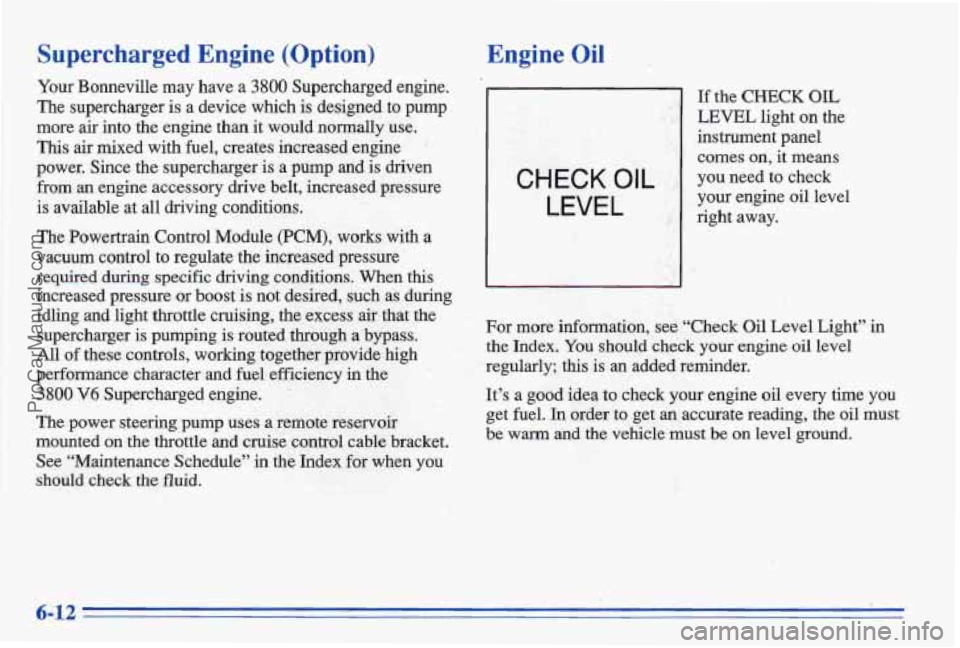
Supercharged Engine (Option)
Your Bonneville may have a 3800 Supercharged engine.
The supercharger is a device which is designed
to pump
more
air into the engine than it would normally use.
This air mixed with fuel, creates increased engine
power. Since the supercharger is a pump
and is driven
from an engine accessory drive belt, increased pressure
is available at all driving conditions.
The Powertrain Control Module (PCM), works with a
vacuum control to regulate the increased pressure
required
during specific driving conditions. When this
increased pressure or boost is not desired, such as during
idling
and light throttle cruising, the excess air that the
supercharger is pumping is routed through
a bypass.
All of these controls, working together provide high
performance character
and fuel efficiency in the
38010 V6 Supercharged engine.
The-power steering pump uses a remote reservoir
mounted on the throttle and cruise control cable bracket.
See “Maintenance Schedule”
in the Index for when you
should check the fluid.
I ’. .. ,- .. .. , . -. :? 1
Engine Oil
CHECK OIL
LEVEL
If the CHECK OIL
LEVEL light on the
instrument panel comes
on, it means
you need to check
your engine oil level
right away.
For more information, see “Check Oil Level Light”
in
the Index. You should check your engine oil level
regularly; this is
an added reminder.
It’s a good idea
to check your engine oil every time you
get fuel. In order to get an accurate reading, the oil must
be warm and the vehicle must be on level ground.
6-12
ProCarManuals.com
Page 305 of 387
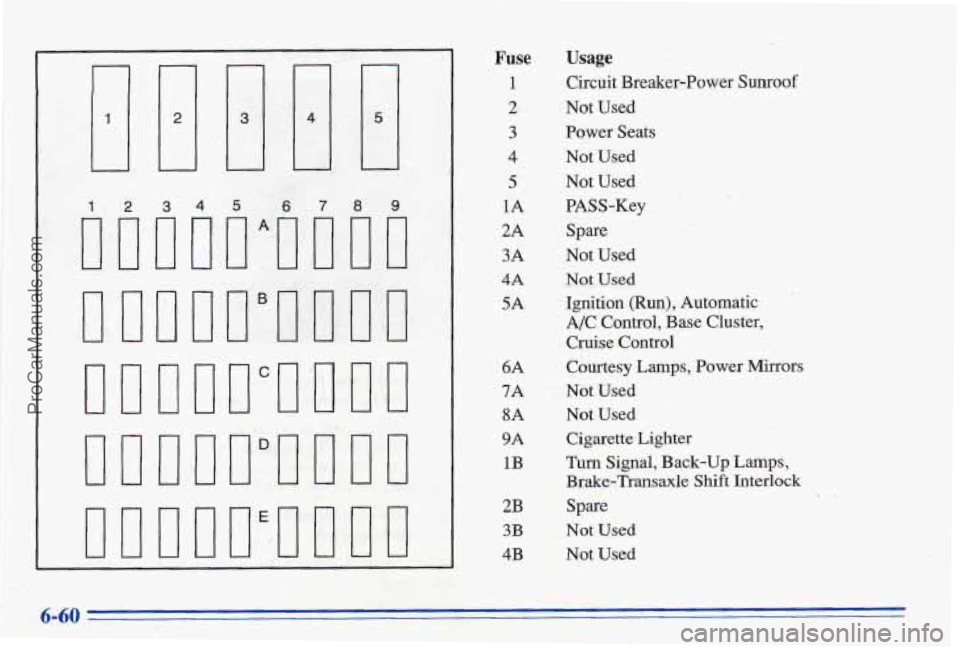
345 6
t
Fuse
1
2
3
4
5
1A
2A
3A
4A
5A
6A
7A
8A
9A
1B
2B
3B
4B
Usage
Circuit Breaker-Power Sunroof
Not Used Power Seats
Not Used
Not Used PASS-Key
Spare
Not Used
Not
Used
Ignition (Run), Automatic
AJC Control, Base Cluster,
Cruise Control
Courtesy Lamps, Power Mirrors
Not Used
Not Used Cigarette Lighter
Turn Signal, Back-up Lamps,
Brake-Transaxle Shift Interlock
Spare
Not Used
Not Used
6-60
ProCarManuals.com
Page 355 of 387

Part C: Periodic Maintenance
Inspections
Listed below are iqspections and services which should
be performed at least twice
a year (for instance, each
spring and fall). You should let your GM dealer’s
service depkent or other qualified service center do
these jobs. Make sure any necessary repairs
are
completed at once.
Proper procedures to perform these services may be
found in a Pontiac service manual. See “Service and
Owner Publications” in the Index.
Steering, Suspension and Front- Wheel-Drive
Axle Boot and Seal Inspection
Inspect the front and rear suspension and steering system
for damaged, loose or missing parts,
signs of we&, or lack
of lubrication. Inspect the power steering hs d hoses
for proper hook-up, binding, leaks, cracks, chafing,
etc.
Clean and then inspect the drive axle boot seals for
damage, tears or leakage. Replace seals if necessary.
..-
,-’; .. :-: : :I . -. :;Exhaust System Inspe,ction
3 ,.
.’Inspect the complete exhaust system. Inspect the body near
the exhaust system. Look for broken, damaged, missing or
out-of-position parts as well as open seams, holes, loose
_.
connections, or other conditions which could cause a heat
build-up
in the floor pan or could let exhaust fumes into
the vehicle.
See “Engine Exhaust’’ in the Index.
Radiator and Heater Hose Inspection
Inspect the hoses and have them replaced if they are
cracked, swollen or deteriorated. Inspect all pipes,
fittings and clamps; replace as needed.
Throttle Linkage Inspection
Inspect the throttle Wage for interference or binding, and
for damage or missing parts. Replace parts as needed.
Replace any cables that have high effort or excessive wear.
Do not lubricate accelerator and cruise control cables.
Brake System Inspection
Inspect the complete system. Inspect brake lines and
hoses’ for proper hookup, binding, leaks, cracks, chafing,
etc. Inspect disc brake pads for wear
and rotors for
surface condition.
Also inspect drum brake linings for
wear and cracks. Inspect other brake
pans, including
drums, wheel cylinders, calipers, parking brake, etc.
Check pvking brake adjustment. You may need to have
your brakes inspected more often if your cjriving habits
or conditions result in frequent braking.
ProCarManuals.com
Page 376 of 387
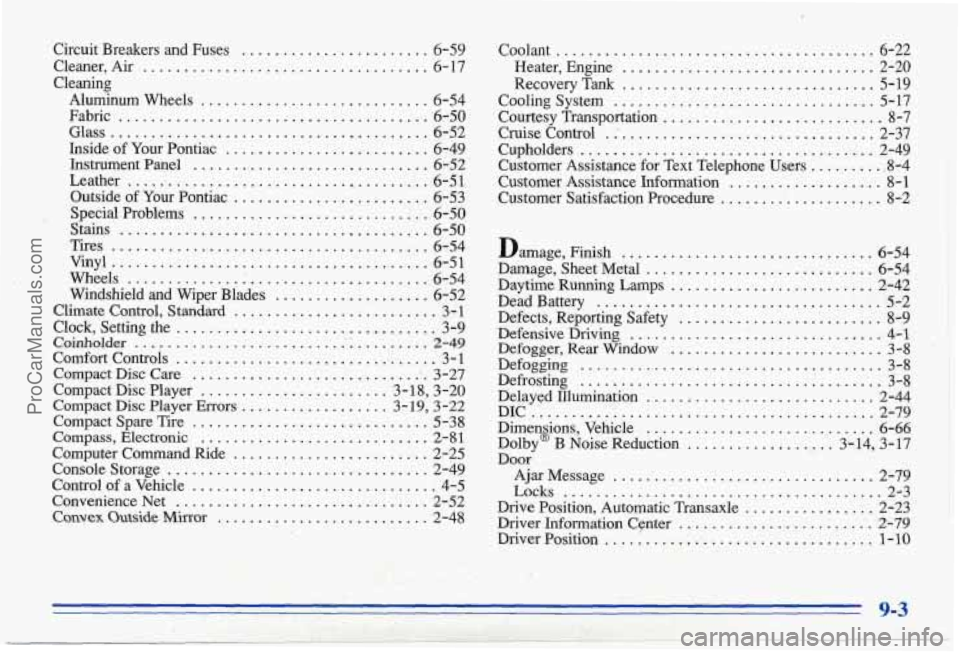
Circuit Breakers and Fuses ................... 6-59
Cleaner.
Air .................. : ................. 6-17
Cleaning
Aluminum Wheels ............................ 6-54
Fabric
...................................... . 6-50
Glass ....................................... 6-52
Inside of Your Pontiac
......................... 6-49
Instrument Panel
.............................. 6-52
Leather
...................................... 6-5 1
Outside of Your Pontiac ........................ 6-53
Special Problems
............................. 6-50
Stains ...................................... 6-50
Tires ........................................6-54.
Vinyl ....................................... 6-51
Wheels .............. ...................... 6-54
Windshield and Wiper Blades
................... 6-52
Climate Control,
Standard ......................... -3 - 1
Clock, Setting the ................................. 3-9
Coinholder 2-49
.. Comfort Controls ................................ 3-1
Compact Disc Care
.............................. 3-27
Compact Disc Player ....................... 3 - 18, 3-20
Compact
Disc Player Errors ................... 3-19,3. -22
Compact Spare Tire ............................. 5-38
Compass, Electronic
............................ 2-8 1
Computer Command Ride ........................ 2-25
Console Storage
.................................. 2-49
Control
of a Vehicle .............................. 4-5
Convenience Net
............................... 2-52
Convex Outside Mirror .......................... 2-48
.. ....................................
Coolant ....................................... 6-22
Heater, Engine ............................... 2-20
Recovery Tank
............................... 5-19
Cooling System ................................ 5-17
Courtesy Transportation ........................... 8-7
Cruise Control
. : ............................... 2-37
Cupholders .................................... 2-49
Customer Assistance for Text Telephone Users
......... ,8-4
Customer Assistance Information
................... 8-1
Customer Satisfaction Procedure ..................... 8-2
Damage. Finish ............................... 6-54
Damage. Sheet Metal
............................ 6-54
Daytime Running
Lamps ......................... 2-42
Dead Battery
................................... 5-2
Defects. Reporting Safety
......................... 8-9
Defensive Drivin
................................ 4-1
Defogger. Rear Vfindow .......................... 3-8 .
Defogging ..................................... 3-8
Defrosting
..................................... 3-8
Delayed Illumination
............................ 2-44
Dimen8ions. Vehicle
............................ 6-66
Dolby B Noise Reduction .................. 3-14, 3-17
Ajar Message
................................ 2-79
Drive Position. Automatic Transaxle
................ 2-23
Driver Information Center
........................ 2-79
DIC.' .......................................... 2-79
Door
Locks ....................................... 2-3
Driver Position .................................. 1-10
9-3 .. ... .... ................ -. .;,. I: ! -- .. L ..__ ........ -~~ ProCarManuals.com